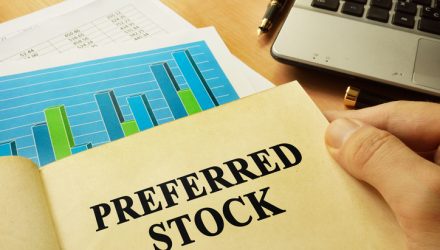Buoyed by low interest rates and investors’ thirst for additional income, preferred stock ETFs are putting together some impressive showings this year. For example, the Invesco Preferred ETF (PGX), one of the oldest ETFs dedicated to this asset class, is higher by nearly 11% while yielding 5.23%.
The Invesco Preferred ETF is based on The ICE BofAML Core Plus Fixed Rate Preferred Securities Index. The Fund will normally invest at least 80% of its total assets in fixed rate US dollar-denominated preferred securities that comprise the Index. The Index tracks the performance of fixed rate US dollar-denominated preferred securities issued in the US domestic market. (Securities must be rated at least B3, based on an average of three leading ratings agencies: Moody’s, S&P and Fitch) and must have an investment-grade country risk profile (based on an average of Moody’s, S&P and Fitch foreign currency long-term sovereign debt ratings). The Fund and the Index are rebalanced and reconstituted on a monthly basis.
Preferred stocks are a type of hybrid security that show bond- and equity-like characteristics. The shares are issued by financial institutions, utilities and telecom companies, among others. Within the securities hierarchy, preferreds are senior to common stocks but junior to corporate bonds. Additionally, preferred stocks issue dividends on a regular basis, but investors don’t usually enjoy capital appreciation on par with common shares.
“While preferred stocks represent ownership in a company similar to a stock, these equities function somewhere in between bonds and stocks for income-seeking investors, says Mitch Tuchman, chief investment officer at Rebalance, a California-based retirement provider,” reports Ellen Chang for US News & World Report.
Preferred Power
The $5.65 billion PGX, which is nearly 12 years old, holds 287 preferred stocks. About two-thirds of the fund’s holdings are issued by financial services companies. A large weight to that sector isn’t uncommon among preferred ETFs because those companies were massive issuers of preferreds during the financial crisis, using the securities to raise capital.
Preferred stock also acts like a bond. A par value is assigned on issue and this price rises or falls based on interest rates. When interest rates go up, the par value of the shares is diminished, just like bonds. Some preferred shares even have a maturity date where the investors’ capital is returned. Finally, some preferred shares are callable, meaning the company can decide at any time to repurchase the shares (although usually at a premium).
For its part, PGX has a modified duration of 3.56 years and a weighted average coupon of 5.98%, according to issuer data.
“Bond coupons are usually taxed at ordinary income tax rates, experts say. While preferred stock dividends often come with favorable tax characteristics and are classified as qualified dividends. The maximum long-term capital gains rate is 20%, depending on taxable income and filing status,” according to US News.
For more tactical strategies, visit our Tactical Allocation Channel.
The opinions and forecasts expressed herein are solely those of Tom Lydon, and may not actually come to pass. Information on this site should not be used or construed as an offer to sell, a solicitation of an offer to buy, or a recommendation for any product.








